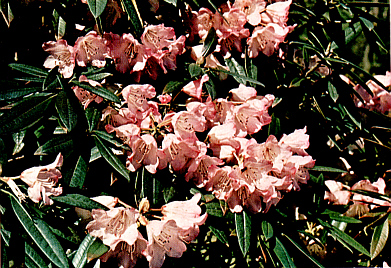QBARS - v29n2 Rhododendron adenophorum
Rhododendron adenophorum
John M. Fogg, Jr.
Director of the Barnes Foundation, Merion, PA

|
|---|
R. adenophorum Photo by John M. Fogg Jr. |
In a brief note in the Newsletter of the Arboretum of the Barnes Foundation (Number 13:12. September 1974) I called attention to the fact that we have a fine specimen of Rhododendron adenophorum Balf. & Sm. growing here at the arboretum. This note has generated a gratifying response; several readers have requested scions or rooted cuttings and Mr. Fred Galle, of Calloway Gardens, has suggested that I prepare a more extensive account for this Bulletin. I had already considered doing this, but felt that I should first ascertain whether this species is as uncommon in cultivation as I had been led to believe.
My first inquiry was directed to my good friend, Dr. John C. Wister, who informed me that in his opinion the plant is not widely cultivated in the United States. The United States National Arboretum was not certain whether the species is extant in their collections. Mr. Joseph A. Witt, of the University of Washington Arboretum, at Seattle states that it may have been cultivated thereat one time, but is not grown there at present. Mr. David G. Leach, President of the American Horticultural Society and an eminent authority on rhododendrons, writes, "You are perfectly safe in describing R. adenophorum as a rarity," and adds, "It is so even in England, land of rhododendron plenty. I can recall having seen only two plants of this species; one at Exbury and one at the Earl of Stair's estate."
In the light of these observations it seems desirable to repeat several of the comments contained in my earlier note and to augment them by a more detailed description concerning the origin and characteristics of this species.
Sometime during the 1950's (our records which are usually rather accurate do not reveal just when) Mrs. Laura L. Barnes, then Director of the Barnes Arboretum, received from the U. S. National Arboretum a rhododendron labeled merely "Glen Dale 209" and as such it was identified in our files for about a decade and a half.
In the spring of 1971, feeling confident that this plant had nothing in common with other Glen Dales, I sent herbarium specimens of flowering and fruiting material to Dr. Henry T. Skinner, then Director of the National Arboretum and a recognized authority on the genus Rhododendron . I asked him to kindly let me know whether this "Glenn Dale" number had ever been accorded a specific or cultivar name and to give me any additional information they had concerning the origin and history of this species.
Dr. Skinner turned this problem over to Dr. T. R. Dudley, a member of his staff, who on June 15, 1971, wrote to me stating that "209 is not a Glenn Dale number, but is an early National Arboretum number presumably (?) applied by Francis de Vos circa 1952." He adds that they do not know whether the plant is extant on their grounds and states that the original seed source to Glenn Dale was from A. N. Stewart in 1933 from Lushan, University of Nanking, in the Kiangsi Province of West China. He goes on to say, "I strongly suspect that Steward did not collect the seed in the wild, but rather collected it from cultivated material at the Lushan Arboretum. I further suspect that the introduction of this plant to the Lushan Arboretum stemmed from George Forrest."
To this somewhat ambiguous account of the origin of this species should be appended Dr. Dudley's further statement, as follows, "I think I have narrowed the identity down to R. adenophorum Balf. & Sm. or R. adenogynum Diels..it may be that these two epithets are synonymous...for the time being let's refer to your plant as "R. adenophorum" .
Regardless of whatever the correct name of this species may turn out to be, it seems desirable to call attention to the characteristics which have made it one of the most admired plants in our collection. Our specimen, as indicated, is probably about 20 years old. It is almost 6 ft. tall and approximately the same width. Its elliptic, leathery leaves are from 10 to 12 cm. long and 1.5 to 2.0 cm. wide. They are dark green above and densely rufous-pubescent beneath. The flower buds are a rich rosy-red. but the corollas when fully open are a luscious clear pink, sparingly speckled in the throat. The dark brown capsules are 15-18 mm. long and are clothed with short gland-tipped hairs.
In his letter to me Dave Leach says that, "These Taliense things usually take about 25 years to bloom" (Ours apparently has made it in something less) and adds that, once they get going, "They are handsome, luxuriantly foliaged, attractively flowered rhododendrons."
As I mentioned in my original note, Mr. Ross Davis, a very able horticulturist, has been eminently successful in rooting cuttings of this plant and we have a limited number ready for distribution. We shall also be glad to forward scions to those who request them, our chief desire being to make this handsome species available to rhododendron lovers throughout the country.
We would be pleased to hear from other growers who may possess fuller information concerning the occurrence of this plant in cultivation.

